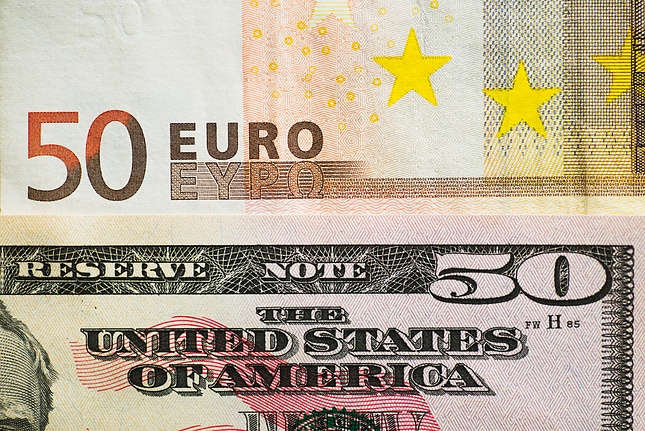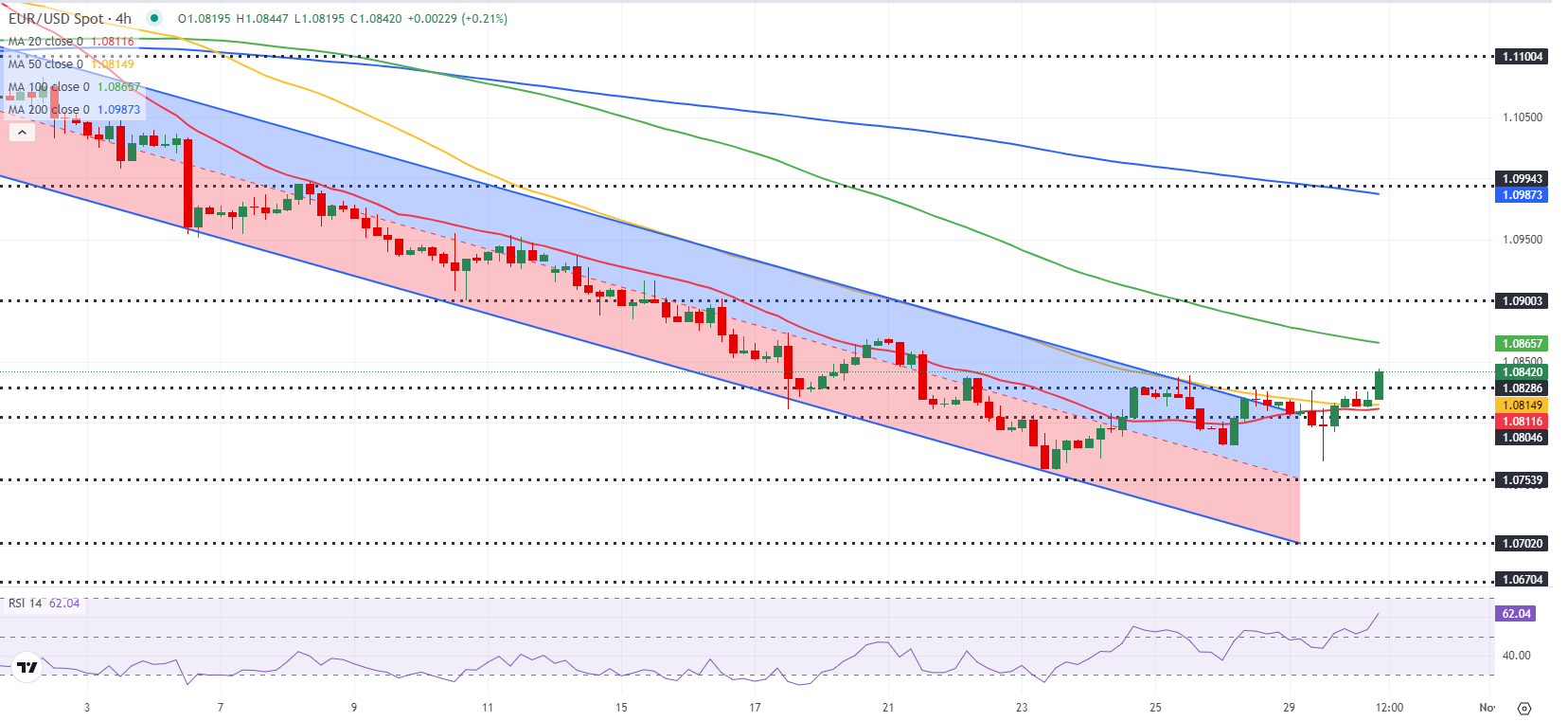- EUR/USD edges higher toward 1.0850 in the European session on Wednesday.
- Investors will have many data releases from Germany, the Eurozone and the US to assess.
- The technical outlook points to a buildup of bullish momentum.
EUR/USD gains traction and rises toward 1.0850 in the European trading hours on Wednesday. Although the technical outlook highlights a buildup of bullish momentum, the Euro still faces a two-way risk on high-impact macroeconomic data releases.
Euro PRICE Today
The table below shows the percentage change of Euro (EUR) against listed major currencies today. Euro was the strongest against the US Dollar.
| USD | EUR | GBP | JPY | CAD | AUD | NZD | CHF | |
|---|---|---|---|---|---|---|---|---|
| USD | -0.22% | -0.05% | -0.21% | -0.08% | -0.29% | -0.38% | -0.11% | |
| EUR | 0.22% | 0.17% | 0.00% | 0.14% | -0.07% | -0.16% | 0.11% | |
| GBP | 0.05% | -0.17% | -0.18% | -0.03% | -0.24% | -0.33% | -0.04% | |
| JPY | 0.21% | 0.00% | 0.18% | 0.15% | -0.06% | -0.17% | 0.12% | |
| CAD | 0.08% | -0.14% | 0.03% | -0.15% | -0.22% | -0.30% | -0.01% | |
| AUD | 0.29% | 0.07% | 0.24% | 0.06% | 0.22% | -0.10% | 0.20% | |
| NZD | 0.38% | 0.16% | 0.33% | 0.17% | 0.30% | 0.10% | 0.29% | |
| CHF | 0.11% | -0.11% | 0.04% | -0.12% | 0.01% | -0.20% | -0.29% |
The heat map shows percentage changes of major currencies against each other. The base currency is picked from the left column, while the quote currency is picked from the top row. For example, if you pick the Euro from the left column and move along the horizontal line to the US Dollar, the percentage change displayed in the box will represent EUR (base)/USD (quote).
Regional Consumer Price Index (CPI) figures and third-quarter Gross Domestic Product (GDP) data from Germany will be watched closely by market participants. Investors expect Germany's GDP to contract at an annualized rate of 0.3% in the third quarter. A worse-than-expected GDP print, combined with soft regional inflation figures from Germany, could weigh on the Euro with the immediate reaction.
Later in the day, the ADP Employment Change for October will be featured in the US economic docket. Analysts see the employment in private sector rising by 115,000 following the 143,000 increase recorded in September.
Additionally, the US Bureau of Economic Analysis will publish its first estimate of the third-quarter GDP data, which is forecast to show an expansion at an annual rate of 3%.
In case the ADP and the GDP data both disappoint, the US Dollar (USD) is likely to come under renewed selling pressure and open the door for a leg higher in EUR/USD. On the flip side, the USD could regather its strength if these data arrive near or above market consensus. If the figures come in mixed, investors could refrain from taking large positions. In this scenario, the risk perception following the Wall Street's opening bell could be the driving factor for the USD's performance.
EUR/USD Technical Analysis
EUR/USD broke out of the descending regression channel and the Relative Strength Index (RSI) indicator on the 4-hour chart rose to 60, reflecting a bullish shift in the short-term technical bias.
On the upside, the 200-day Simple Moving Average aligns as strong resistance at 1.0870 ahead of 1.0900 (round level) and 1.0940 (100-day SMA). Looking south, first support could be spotted at 1.0810-1.0800 (20-period SMA, 50-period SMA, round level) before 1.0750 (static level) and 1.0700 (round level, static level).
Euro FAQs
The Euro is the currency for the 19 European Union countries that belong to the Eurozone. It is the second most heavily traded currency in the world behind the US Dollar. In 2022, it accounted for 31% of all foreign exchange transactions, with an average daily turnover of over $2.2 trillion a day. EUR/USD is the most heavily traded currency pair in the world, accounting for an estimated 30% off all transactions, followed by EUR/JPY (4%), EUR/GBP (3%) and EUR/AUD (2%).
The European Central Bank (ECB) in Frankfurt, Germany, is the reserve bank for the Eurozone. The ECB sets interest rates and manages monetary policy. The ECB’s primary mandate is to maintain price stability, which means either controlling inflation or stimulating growth. Its primary tool is the raising or lowering of interest rates. Relatively high interest rates – or the expectation of higher rates – will usually benefit the Euro and vice versa. The ECB Governing Council makes monetary policy decisions at meetings held eight times a year. Decisions are made by heads of the Eurozone national banks and six permanent members, including the President of the ECB, Christine Lagarde.
Eurozone inflation data, measured by the Harmonized Index of Consumer Prices (HICP), is an important econometric for the Euro. If inflation rises more than expected, especially if above the ECB’s 2% target, it obliges the ECB to raise interest rates to bring it back under control. Relatively high interest rates compared to its counterparts will usually benefit the Euro, as it makes the region more attractive as a place for global investors to park their money.
Data releases gauge the health of the economy and can impact on the Euro. Indicators such as GDP, Manufacturing and Services PMIs, employment, and consumer sentiment surveys can all influence the direction of the single currency. A strong economy is good for the Euro. Not only does it attract more foreign investment but it may encourage the ECB to put up interest rates, which will directly strengthen the Euro. Otherwise, if economic data is weak, the Euro is likely to fall. Economic data for the four largest economies in the euro area (Germany, France, Italy and Spain) are especially significant, as they account for 75% of the Eurozone’s economy.
Another significant data release for the Euro is the Trade Balance. This indicator measures the difference between what a country earns from its exports and what it spends on imports over a given period. If a country produces highly sought after exports then its currency will gain in value purely from the extra demand created from foreign buyers seeking to purchase these goods. Therefore, a positive net Trade Balance strengthens a currency and vice versa for a negative balance.
Information on these pages contains forward-looking statements that involve risks and uncertainties. Markets and instruments profiled on this page are for informational purposes only and should not in any way come across as a recommendation to buy or sell in these assets. You should do your own thorough research before making any investment decisions. FXStreet does not in any way guarantee that this information is free from mistakes, errors, or material misstatements. It also does not guarantee that this information is of a timely nature. Investing in Open Markets involves a great deal of risk, including the loss of all or a portion of your investment, as well as emotional distress. All risks, losses and costs associated with investing, including total loss of principal, are your responsibility. The views and opinions expressed in this article are those of the authors and do not necessarily reflect the official policy or position of FXStreet nor its advertisers. The author will not be held responsible for information that is found at the end of links posted on this page.
If not otherwise explicitly mentioned in the body of the article, at the time of writing, the author has no position in any stock mentioned in this article and no business relationship with any company mentioned. The author has not received compensation for writing this article, other than from FXStreet.
FXStreet and the author do not provide personalized recommendations. The author makes no representations as to the accuracy, completeness, or suitability of this information. FXStreet and the author will not be liable for any errors, omissions or any losses, injuries or damages arising from this information and its display or use. Errors and omissions excepted.
The author and FXStreet are not registered investment advisors and nothing in this article is intended to be investment advice.
Recommended Content
Editors’ Picks

AUD/USD shift its attention to 0.6600 and beyond
AUD/USD left behind Friday’s decline and rose past the 0.6500 barrier, meeting resistance once again around the 0.6550 zone on the back of the pronounced sell-off in the US Dollar.

EUR/USD: Initial contention aligns near 1.0330
The sharp decline in the Greenback allowed EUR/USD to regain some composure and reclaim the 1.0500 hurdle at the beginning of the week ahead of key releases on both sides of the ocean.

Gold turns bearish and could test $2,600
After recovering toward $2,700 during the European trading hours, Gold reversed its direction and dropped below $2,650. Despite falling US Treasury bond yields, easing geopolitical tensions don't allow XAU/USD to find a foothold.

MicroStrategy set to push Bitcoin to new highs after 55,500 BTC acquisition, should investors be concerned?
MicroStrategy revealed on Monday that it made another heavy Bitcoin purchase, acquiring 55,500 BTC for $5.4 billion at an average rate of $97,862 per coin.

Eurozone PMI sounds the alarm about growth once more
The composite PMI dropped from 50 to 48.1, once more stressing growth concerns for the eurozone. Hard data has actually come in better than expected recently – so ahead of the December meeting, the ECB has to figure out whether this is the PMI crying wolf or whether it should take this signal seriously. We think it’s the latter.

Best Forex Brokers with Low Spreads
VERIFIED Low spreads are crucial for reducing trading costs. Explore top Forex brokers offering competitive spreads and high leverage. Compare options for EUR/USD, GBP/USD, USD/JPY, and Gold.
